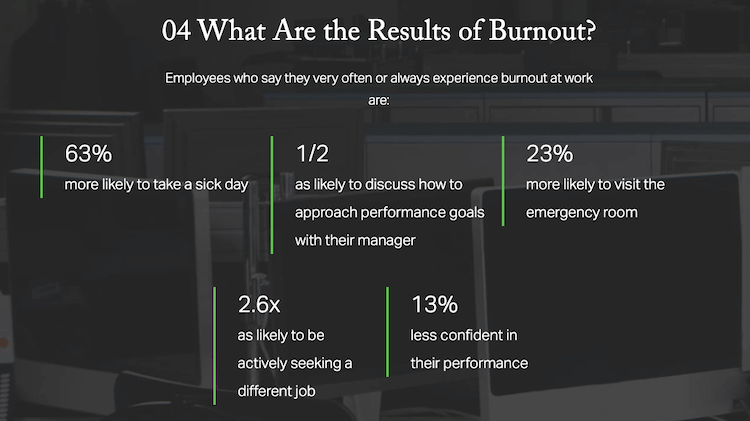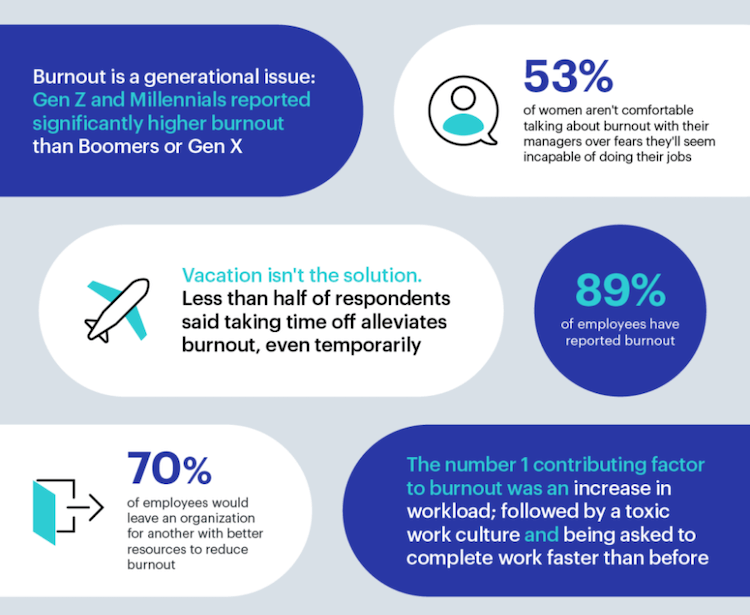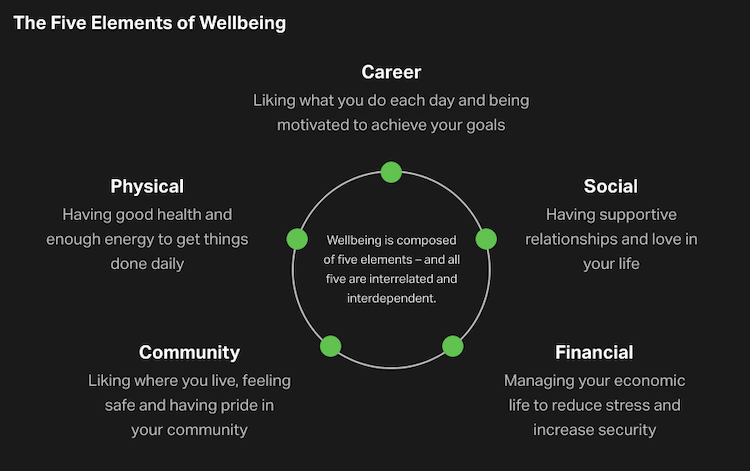What is employee burnout?
Employee burnout is an unpleasant mixture of work stress, exhaustion, and negative, cynical feelings. It’s closely connected to our job and our workplace, and the World Health Organisation recognises and defines this ‘occupational phenomenon’ as follows:
Burn-out is a syndrome conceptualised as resulting from chronic workplace stress that has not been successfully managed. It is characterised by three dimensions:
- feelings of energy depletion or exhaustion;
- increased mental distance from one’s job, or feelings of negativism or cynicism related to one’s job; and
- reduced professional efficacy.
One 2021 report found that 42% of American women and 35% of American men felt burned out ‘often or almost always’ in 2021. This is a huge proportion of the US workforce. Research also shows that 44% of US employees say they’re planning to look for a new job in the next year, in the phenomenon known as The Great Resignation.
Time was, employee burnout was viewed as a workers’ problem: if you were going to make a success of your career in the rat race, you had to manage your own mental health, self-care, and work-life balance to cope with whatever the job and your managers decided to throw at you.
Increasingly, though, employee burnout is considered a problem with the company, not the workers, and it’s up to business leaders to address the issue.
Start listening to your employees with our free survey software
What are the signs of employee burnout?

As well as bearing in mind these statistics from Gallup above, leaders and managers need to look out for these signs of employee burnout in their teams:
- Increase in absenteeism
- Decrease in productivity
- Making more mistakes
- Difficulty remembering things
- Unmotivated and unenthusiastic about the job
- Poor decision-making
- Irritability and overly sensitive to feedback
- Cynical and negative attitude
- Exhaustion due to difficulty sleeping
- Lack of interest in workplace culture
Burned-out employees lose their mojo to learn new things or grow within their roles. It’s as much as they can do to get through each day at work, let alone focus positively on future development. No company is going to thrive when its employees feel like this.
What causes employee burnout?
Companies with burned-out employees tend to demonstrate three traits:
- Over-collaboration: While collaborative working can be great for innovation and creativity, too many meetings, reports, brainstorming sessions, and presentations can overwhelm workers who just want to quietly get on with the current task at hand in their own sweet time.
- Poor time management: setting unrealistic deadlines; over- or under-estimating the time needed to do tasks and failing to appreciate the pace at which each employee works can put time stress onto your teams.
- Overload their stars: the saying ‘If you want to get the job done, ask a busy person’ means that the most capable employees are given the most work. It’s a mistake to overestimate the amount of work you think your team members can handle, and just because talented employees can work three times as fast as their co-workers, this doesn’t mean you can give them three times as many tasks.
The employees’ take on what makes them feel burned out gives us a handy list of the Top 10 things not to do:
- Asking employees to take on a bigger workload
- Toxic workplace culture that does not stamp out bullying, gossip, oppressive behaviour (sexism, racism, homophobia, etc.), office politics, unfair treatment
- Being urged to work faster
- Micromanagement
- No control over timescales, schedules, workload, projects
- Physical demands, such as sitting or standing all day, walking miles, heavy lifting
- Unclear job expectations and lack of support from line managers, leaders, co-workers
- Being forced to come back into the office
- Lack of work-life balance, such as long hours and weekend working, always-on email and messaging encroaching into personal life
- Geopolitical world events, such as Covid-19, the climate emergency, racial injustices, terrorism
The effects of employee burnout
Nobody benefits from overworking and burning out employees.
- For the employees themselves: At the very least, burnout leaves employees disengaged, disinterested, and performing poorly. More seriously, overwork and burnout can exact a terrible toll on people’s physical and mental health. Emotional exhaustion, anxiety, depression, addiction, sleep problems, gastrointestinal conditions, headaches, workplace accidents, and even serious health conditions such as cardiovascular disease and Type 2 diabetes can be linked to chronic stress at work.
- For the business: Every aspect of employee burnout – absenteeism, poor performance, decreased productivity, health issues, higher healthcare costs, accidents, talent attrition, and re-recruitment affects the bottom line, and can even go further into brand reputational damage and legal claims.

Image from Visier.com
How can you alleviate employee burnout?
When LinkedIn, Hootsuite, and Bumble gave all their employees a week off in summer 2021 to fight ‘Covid burnout’, they made headlines around the world as caring companies who recognised the toll of overwork and classic burnout on their people. But interestingly, fewer than half of employees feel that taking time off alleviates their feelings of burnout. And as Christina Maslach, a social psychologist, observes, “If the best thing you can do for your employees is to tell them not to come to work, what is wrong with the work?”
It seems that the answer to fixing employee burnout is ‘fix the work’. So how can you do that, and create an employee-centric culture?
Put wellbeing at the heart of your workplace

Image from Gallup
When an organisation embeds wellbeing into its culture as the norm, rather than as a ‘nice-to-have’ on a human resources checklist, employees are more inclined to take good care of their physical and mental health and speak up when something’s not right. An organisation can incorporate all five elements of wellbeing, and by doing so, the management of burnout follows along naturally:
- Career – liking what you do each day and being motivated to achieve your goals: Managers can help this happen by apportioning tasks fairly to every member of the team so that everyone gets tasks that interest and develop them, and give them job satisfaction. Well-trained managers will be able to motivate team members towards shared goals.
- Social – having supportive relationships and love in your life: Fostering a workplace culture that is diverse and inclusive, with bonded, supportive teams.
- Financial – managing your economic life to reduce stress and increase security: Employees receive good pay and benefits for the work they do, perhaps with an employee assistance program, and feel contractually safe in their jobs.
- Community – liking where you live, feeling safe, and having pride in your community: A safe, pleasant working environment that everyone feels proud to work in.
- Physical – Having good health and enough energy to get things done daily: Healthcare plans, gym subscriptions, work sports clubs, exercise classes for mind and body, breaks to get out into the fresh air.
Make managers responsible for avoiding burnout
Where traditional management went for a ‘command-and-control’ dictatorial style that caused harmful work stress, making modern managers responsible for avoiding burnout changes that whole dynamic. A manager should:
- Listen to employees: what’s working and what isn’t, and take action
- Set clear goals, expectations, schedules, and balanced workloads, and prepare to be flexible
- Encourage collaboration, but don’t overdo it
- Support employees to do their best work, maybe automating tedious tasks
- Model behaviour: don’t work through lunch or on vacation, or not take PTO, as this encourages employees to do the same
- Recognise early signs of employee stress and act on them by asking how employees are, their highs and lows, and how they can help make work easier
Make employee experience the best it can be
“Choose a job you love and you’ll never have to do a day’s work in your life” so the saying goes, and employees who love their jobs tend not to be the ones who burn out. By creating the best employee experience, you help reduce the root causes of workplace burnout, as employees love working for your company.
There are 10 golden rules for creating the best employee experience, and at every one of them, you can put in strategies to reduce burnout:
- Job application: Keep it simple and let candidates know exactly what the role entails, so there are no stressful surprises
- Hire the right talent: When the person fits the job description and the culture, chances are they’ll love their work rather than struggle with it
- Express the ‘why’: Having a purpose to work for, and inspiring leadership backing it, can help reduce burnout
- Give great onboarding: a great onboarding experience paves the way for increasing employee engagement and employee retention
- Gather frequent employee feedback to find out about any issues causing burnout
- Act on that feedback to stop burnout in its tracks
- Communicate: you can’t fix what you don’t know about, so make sure communication channels are always open
- Give feedback: Regular, transparent, constructive feedback can help employees improve their working style and boost their confidence
- Flexibility: Ditch the 9-5, let employees hybrid work, trust them to be autonomous and do their best work
Make mental health a priority
Job burnout results from the stress of an overwhelming workload, inflexibility, lack of direction and clarity, micromanagement, and unfair treatment. These all affect employees’ mental health and can lead to breakdowns and staff turnover. Devise a mental health strategy that:
- Employees know about and trust
- Gives employees control of their schedule, within flexible, set boundaries
- Helps mitigate stressful workloads
- Offers an employee assistance program (EAP)
- Encourages employees to take ‘headspace’ breaks throughout the day
- Offers meditation/mindfulness/yoga sessions
- Makes everyone take all their vacation days
- Offers a safe space for expressing emotion, concerns or worries about work
- Encourages open and transparent two-way communication
How technology can help reduce employee burnout
When you use an experience management platform such as Qualtrics Employee XM, you’ll be able to tell from survey responses and 360 feedback how your employees are feeling, and pick up the first stages of burnout, ready to take action immediately. And when you combine your operational (O) data and experience (X) data, you’ll also be able to pick up signs of burnout with metrics such as absenteeism, employee turnover, customer satisfaction, and employee engagement. Combining O and X data gives you a more holistic view of your organisation so you can step in and remedy problems before they burn out your employees.
Start listening to your employees with our free survey software